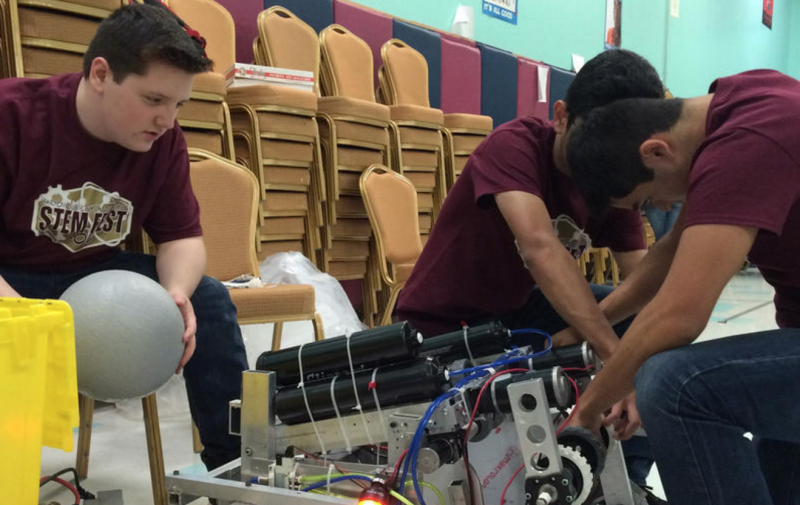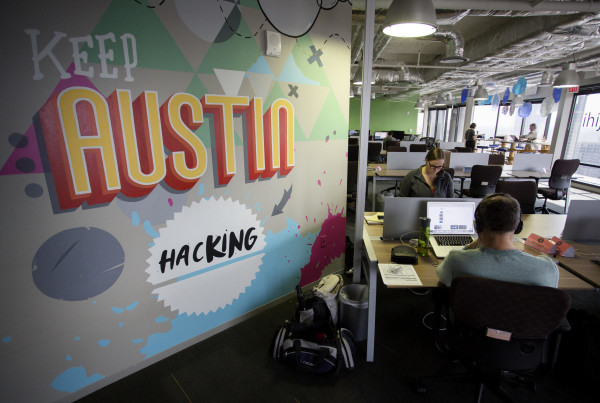This story originally appeared on Heart of Texas Public Radio.
Inside Harmony Science Academy, the Devastators – a team of students from the school – are showing off Impulse, the robot they’ve designed for the FIRST Robotics Competition. Here, Impulse, which kind of looks like a much smaller and squatter version of the Mars Curiosity rover, is zipping across the cafeteria floor. It’s powered by a drivetrain system that controls the eight wheels it sits on.
It also uses a smaller system of wheels to pick up balls, which a series of air tanks launches into the air. All of these features, senior Safiq Sindha says, will help their team to effectively compete in this year’s competition.
“The challenge changes every year,” Sindha says. “This year it’s a medieval theme called ‘Stronghold’. So what we have to do is essentially what we call boulders or 10-inch balls into goals that are … 7-feet high, all while defending ourselves against other players and things like that.”
The game is played in alliances, or groups made up of 3 different teams. The beginning of each match starts with 15 seconds where the robot is completely autonomous. Sindha says this is to test a teams’ programming capabilities. From there, it’s a furious match that lasts 2 minutes and 15 seconds. A video released by FIRST explains the intricacies of the match.
To win the match, your team has to score the most points by conquering obstacles and launching boulders into an opponent’s tower. But designing, building and programming a robot to do all of this wasn’t easy, says Sindha. The Devastators – like all of the roughly 3,000 other teams that compete – had to not only build their robot, but also raise money for it and design a team brand. In total, the team has raised roughly $23,000, through grants and sponsorships. A large portion of this sum will go towards travel expenses, but when it comes to parts, each team can only spend $5,000 for their robot. However, if a sponsor – say a sheet metal shop – wanted to cut and donate metal to a team, that wouldn’t count towards the $5,000 cap. Devastators head coach and teacher Tiffani Cortez says big sponsorships, like ones from NASA, makes for pretty steep competition that can feel like a David-versus-Goliath matchup. But win or lose, she says the benefits are much more than learning about robotics.
“[The benefits are] the bonds they create and them realizing the potential of what they’re able to do,” Cortez says. “Some of them have come in here not knowing what the difference in screwdrivers are, and now they’re functioning with all these major tools. It’s great to see them get so confident with the abilities they’ve developed over the time they’ve spent on the team.”
18-year-old Marcos Ibanez has participated in the robotics competition since his freshman year at Harmony. He says through his recent role as the team’s captain of engineering, he’s learned about mentoring and teaching. Next week, as the Devastators head to the first rounds of regional competition in Louisiana, those skills will be put to test in an environment that Sindha, Ibanez and other team members call fast-paced.
“You wouldn’t think it’d be intense ’cause it’s robots, but it does get really intense. Like, it makes you scared at some points. It makes you shake,” Ibanez says, recalling past competitions.
For these high school students, in a state where football is the extracurricular king, robotics – and specifically competing in the FIRST Robotics Competition – is the true sport.
“[A] game on Friday nights, they stop, it kind of goes on for a little bit, here it’s intense throughout the whole competition and you’re working constantly from, you get there at 9 maybe and you don’t leave until 6, 7ish. That’s almost a full day of non-stop work,” Ibanez adds.
Back at the team’s demonstration, younger kids watch wide-eyed as Impulse shoots “boulders” into the air. Sinda says moments like that make the work worth it, from the late nights spent building to the long days during competition.
“We have kids of all ages saying, ‘Whoa, where can I buy one of these?’ And we’re like, ‘We’re sorry you can’t buy it, but if you join a robotics program you can totally build one day.’”















